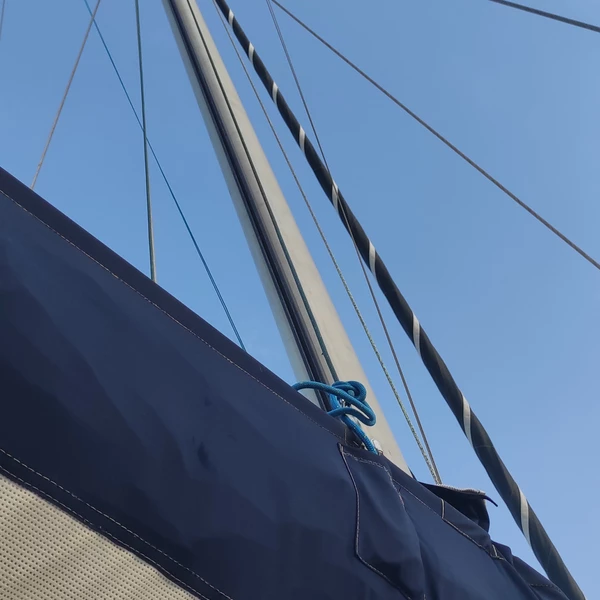Seller's Description
Boat in excellent condition manufactured in Denmark, designed by Jens Grandinsson. Very equipped and never rented: Length - 11.50m Beam - 3.60m Draft - 1.85m Ballast - 1.8 ton Displacement - 8 tons Engine - Volvo Penta MD2030. Full batten mainsails from 2021. Genoa from 2021 with Furlex furler. Lazybag. Spinnaker pole (not in stock). Against Selden 2 Lewmar winches forwarding halyards and reefs. 4 Lewmar winches sheets Wheel rudder with Raymarine GPS. Raymarine ST 2000 autopilot. Hydraulic tensioner in backstay. Electric windlass with control. Complete electronics with GPS and Plotter. Electrical panel with machetes. 2 batteries from 2021 (starting and comfort) Battery charger 2021 Electrical supply 240v on dock New interior light (LEDs) Renovated and cozy interior with 2-burner kitchen, refrigerator, microwave, sink (2 bowls) with hot and cold water, room bathroom with hot and cold water, electric toilet, black water tank, TV, hot/cold shower in bathtub. Speakers in cabin (2) in cockpit (2). 2 cabins, kitchen, bathroom and large dining room for 6 people. Contact: 0034 627948394
Specs
- Designers
- ?
- Builders
- ?
- Associations
- ?
- # Built
- ?
- Hull
- ?
- Keel
- ?
- Rudder
- ?
- Construction
- ?
Dimensions
- Length Overall
- 37′ 8″ / 11.5 m
- Waterline Length
- ?
- Beam
- ?
- Draft
- 6′ 2″ / 1.9 m
- Displacement
- 17,640 lb / 8,000 kg
- Ballast
- 3,970 lb / 1,800 kg
Rig and Sails
- Type
- Sloop
- Reported Sail Area
- ?
- Total Sail Area
- ?
Mainsail
- Sail Area
- ?
- P
- ?
- E
- ?
- Air Draft
- ?
Foresail
- Sail Area
- ?
- I
- ?
- J
- ?
- Forestay Length
- ?
Auxilary Power
- Make
- VOLVO
- Model
- ?
- HP
- 27
- Fuel Type
- FUEL
- Fuel Capacity
- 29 gal / 110 l
- Engine Hours
- 560
Accomodations
- Water Capacity
- 42 gal / 160 l
- Holding Tank Capacity
- ?
- Headroom
- 5′ 6″ / 1.7 m
- Cabins
- 2
Calculations
- Hull Speed
- ?
Hull Speed
The theoretical maximum speed that a displacement hull can move efficiently through the water is determined by it's waterline length and displacement. It may be unable to reach this speed if the boat is underpowered or heavily loaded, though it may exceed this speed given enough power. Read more.
Formula
Classic hull speed formula:
Hull Speed = 1.34 x √LWL
A more accurate formula devised by Dave Gerr in The Propeller Handbook replaces the Speed/Length ratio constant of 1.34 with a calculation based on the Displacement/Length ratio.
Max Speed/Length ratio = 8.26 ÷ Displacement/Length ratio.311
Hull Speed = Max Speed/Length ratio x √LWL
- Sail Area/Displacement
- ?
Sail Area / Displacement Ratio
A measure of the power of the sails relative to the weight of the boat. The higher the number, the higher the performance, but the harder the boat will be to handle. This ratio is a "non-dimensional" value that facilitates comparisons between boats of different types and sizes. Read more.
Formula
SA/D = SA ÷ (D ÷ 64)2/3
- SA: Sail area in square feet, derived by adding the mainsail area to 100% of the foretriangle area (the lateral area above the deck between the mast and the forestay).
- D: Displacement in pounds.
- Ballast/Displacement
- ?
Ballast / Displacement Ratio
A measure of the stability of a boat's hull that suggests how well a monohull will stand up to its sails. The ballast displacement ratio indicates how much of the weight of a boat is placed for maximum stability against capsizing and is an indicator of stiffness and resistance to capsize.
Formula
Ballast / Displacement * 100
- Displacement/Length
- ?
Displacement / Length Ratio
A measure of the weight of the boat relative to it's length at the waterline. The higher a boat’s D/L ratio, the more easily it will carry a load and the more comfortable its motion will be. The lower a boat's ratio is, the less power it takes to drive the boat to its nominal hull speed or beyond. Read more.
Formula
D/L = (D ÷ 2240) ÷ (0.01 x LWL)³
- D: Displacement of the boat in pounds.
- LWL: Waterline length in feet
- Comfort Ratio
- ?
Comfort Ratio
This ratio assess how quickly and abruptly a boat’s hull reacts to waves in a significant seaway, these being the elements of a boat’s motion most likely to cause seasickness. Read more.
Formula
Comfort ratio = D ÷ (.65 x (.7 LWL + .3 LOA) x Beam1.33)
- D: Displacement of the boat in pounds
- LWL: Waterline length in feet
- LOA: Length overall in feet
- Beam: Width of boat at the widest point in feet
- Capsize Screening
- ?
Capsize Screening Formula
This formula attempts to indicate whether a given boat might be too wide and light to readily right itself after being overturned in extreme conditions. Read more.
Formula
CSV = Beam ÷ ³√(D / 64)
- Beam: Width of boat at the widest point in feet
- D: Displacement of the boat in pounds











































